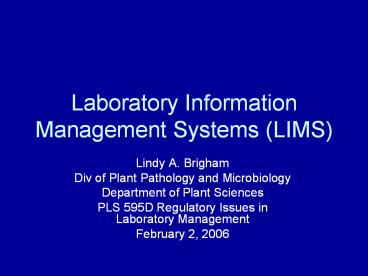Laboratory Information Management Systems (LIMS) - PowerPoint PPT Presentation
Title:
Laboratory Information Management Systems (LIMS)
Description:
Laboratory Information Management Systems (LIMS) Lindy A. Brigham Div of Plant Pathology and Microbiology Department of Plant Sciences PLS 595D Regulatory Issues in ... – PowerPoint PPT presentation
Number of Views:4545
Avg rating:3.0/5.0
Title: Laboratory Information Management Systems (LIMS)
1
Laboratory Information Management Systems (LIMS)
- Lindy A. Brigham
- Div of Plant Pathology and Microbiology
- Department of Plant Sciences
- PLS 595D Regulatory Issues in Laboratory
Management - February 2, 2006
2
LIMS
- Definition
- A method a laboratory uses to manage its data and
disperse the results to designated areas
3
Information Technology
- Why?
- Management of the Information Explosion
- Quality Assurance
- GLP, GMP, EPA, etc.
- Reduction of data entry errors
- Need for faster sample/results turnaround time
4
General Considerations
- Different labs have different requirements
- Procedures and outcomes differ
- But all can use the systems approach to
identifying their needs and implementing solutions
5
Types of Laboratories
- Research
- Analytical Services
- Manufacturing
6
Research Lab
- Many non-routine tests
- Low sample volume
- Flexibility between data and analyses performed
- Specification checking (FDA reqs)
- Traceability (calibration, distribution, data)
- Change control procedures (documentation of
changes eg SOPs, QA compliance)
7
Testing Services Laboratory
- Tests performed at customers request
- High sample volume
- Routine tests
- Variable workload
- Prioritized samples
8
Manufacturing Laboratory
- Perform testing for various materials including
- Final product testing
- Stability testing
- Work-in-progress testing
- Environmental testing
- Raw materials acceptance testing
- Many tests per sample
- Dynamic environment
9
LIMS Acquisition
- How do you determine what you need and how to get
it? - Systems Approach to defining needs and
specifications for a LIMS
10
Acquisition Decisions
- Buy or Build? All or Pieces?
- Options
- Design and build system from scratch
- Piece together existing and off the shelf
components - Buy whole system from vendor
- How do you decide?
11
By doing an Analysis
- The build or buy or buy what decision is made
based on an analysis of the needs and practices
of the lab - The analysis itself can be of benefit to any lab
to - Clarify existing practices
- Help eliminate non-essential practices
- Organize and streamline existing procedures
12
Systems Analysis and Design
- Project Definition
- What is to be achieved, by whom and why
- Functional Requirements
- all user entry requirements and system output
requirements described in detail - Functional Design
- detailed documentation to describe the system and
detail how the functional requirements are to be
achieved independent of hardware and software
requirements - Implementation Design
- selection of hardware and software
- System Integration
- Gather all required components, interface
components, install software, go live - System Evaluation
- Final phase
- Project definition and functional requirements
are revisited and compared to the final installed
system to determine how well the requirements
were met
13
Analysis of UA Research Lab
14
Workflow Overview Research
15
Workflow Overview Analytical
16
Information Management System
- Consists of
- Computer(s)
- People
- Procedures/Processes
17
LIMS Resources
- Stand alone software
- All purpose
- Word Processing
- Spreadsheets
- Databases
- Inventory
- Document Management (Wolk)
- Statistical Packages
- Total systems
- Lablynx http//www.lablynx.com/
- Starlims http//www.starlims.com/
18
Regulatory Requirements
- ISO 9000
- Management must define, implement, communicate
and maintain quality objectives and assign
personnel at all levels of the organization to be
responsible for verifying the companys quality
system - Primarily effect manufacturing laboratories
- ISO 25
- Establishes labs technical competence
- GALP (Good Automated Laboratory Practices)
- Union of federal regulations, policies, and
guidance documents establishing a uniform set of
procedures to ensure the reliability and
credibility of laboratory data (EPA) - 21 CFR 11 (1997)
- Electronic signatures, Electronic records































